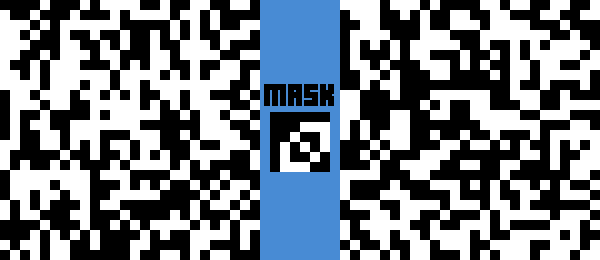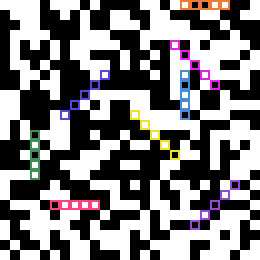Written by Olga Vinogradova and Justin Yokota
Answer: PLATINUM
The puzzle presents a submission box. On submitting a valid English word of length greater than 1, we get a phrase of the form "Single Elimination bracket run on <WORD>. With leftbye, <LETTER> won. With rightbye, <LETTER> won."
As the puzzle implies, two single elimination brackets are run on the individual letters of each word. Each ordered pair of letters (a,b) has a defined winner. We can construct a 26x26 binary image, indexing the rows by the left letter and the columns by the right letter and counting the (a,b)th pixel white if a wins and black if b wins. The two brackets differ in terms of their handling of a round with an odd number of letters; for leftbye, the leftmost letter advances without comparing to another letter, while in rightbye, the rightmost letter advances.
For example, let's look at what happens when we submit ABCDE; for leftbye, A advances, B vs C competes, and D vs E competes in the first round. A, the winners of B vs C, and D vs E advance, to yield a new round of 3 letters. For rightbye, A vs B and C vs D compete, and E advances.
The goal of this puzzle is to determine enough of the 26x26 binary image to extract using the data from Quick Response. Easy starting points are 2-letter and 3-letter words, and words of length 2^n+1 (since this causes the leftmost and rightmost letter to get a bye all the way to the final round).
We also need to use data from Quick Response. In Quick Response, a set of 8 QR code masks were predominantly featured, but only 7 of them were actually used. Per the flavortext, we apply the remaining mask on the 26x26 image.
The entire 26x26 image is shown below. The masked image is on the left, the mask in the center, and the unmasked image is on the right.

In Quick Response, the 8 layers also had sets of 5 "corrupted bits". Taking those corrupted bits and mapping them on the grid yields 5-bit binary letters when read left to right or up to down (in the ones which go diagonally upwards, both directions yield the same letter). The annotated grid is shown below (colors correspond to the final ordering).

Reading the binary letters in order of the bitmask layers in Quick Response yields the answer PLATINUM.
Appendix
Win/Loss Grid (no masking applied)
This is the list of winners for each ordered pair of letters as text. The left letter corresponds to the row and the right letter corresponds to the column; 0 means that left wins and 1 means that right wins.Author's Notes
This puzzle went through quite a few nerfs in writing. Originally, the puzzle was called "Double Elimination", and had teams work out the puzzle on a Double Elimination bracket. This came with an example diagram and only one output of who won; the extraction for this puzzle would have been in the 26x26 image that resulted. At this point, though, none of our entangled pairs had a length 7 answer, so we switched to giving two letters per answer; this constrained the image too much, though, and people couldn't get enough of the image to get the final cluephrase. In switching to Single Elimination, we removed the example diagram to avoid the entanglement from being too obvious; in hindsight, this would have helped disambiguate how to build the final grid.